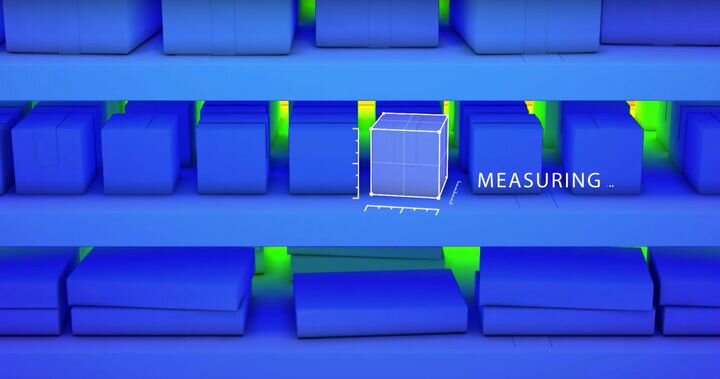![The Intel RealSense LIDAR Camera L515 [Source: Intel]](https://fabbaloo.com/wp-content/uploads/2020/05/lidar_camera_l515_box_img_5eb08c798ee99.jpg)
Intel announced a new depth camera, the inexpensive RealSense LIDAR Camera L515.
A depth camera is a specialized camera that’s used for creating a digital representation of a 3D scene, something commonly done by 3D scanners. The new L515 from Intel uses LIDAR technology.
LIDAR 3D Scanning
LIDAR is a form of 3D scanning in which a pulsed laser fires a beam at an object, and the sensor times the return duration for the reflection. Then it can determine the distance to the object for that pulse.
You might be wondering how a single pulse can be used to create a 3D model. In fact, a depth camera will perform this pulsed duration measurement many times over an array of pixels. Each pixel in the array will be assigned a different distance.
The idea here is to capture a sequence of depth images, each containing an array of distance values. By analyzing the changes from depth frame to depth frame, it’s possible for advanced 3D software to interpret a 3D scene. Typically a point cloud is first developed, where the location of points in 3D space are confirmed. Then the point cloud is transformed into a full 3D mesh, suitable for use in other applications.
Intel RealSense LIDAR Camera L515
![The Intel RealSense LIDAR Camera L515 is incredibly small [Source: Intel]](https://fabbaloo.com/wp-content/uploads/2020/05/image-asset_img_5eb08c79b2568.jpg)
The RealSense LIDAR Camera L515 is quite an advancement as far as depth cameras go. While LIDAR depth cameras have been available for many years, the difference here is the size and pricing.
The RealSense LIDAR Camera L515 is tiny, being only 61mm diameter with a 26mm height, a very small disc. This very small size allows the sensor to be installed in configurations impossible with previous LIDAR sensors. I should mention that the RealSense LIDAR Camera L515 is entirely solid state, so it should be reliable over long periods.
RealSense LIDAR Camera L515 Features
The RealSense LIDAR Camera L515’s weight is also quite important: it weighs only 100g! This means it should be possible to install the sensor into lightweight handheld 3D scanners. Currently, handheld 3D scanners are either quite hefty and difficult to use over long periods, or entangled with cabling to an associated PC running the required software.
The RealSense LIDAR Camera L515 is actually two cameras in one. The LIDAR portion is able to capture a 1024 x 768 array of depth values at 30 frames per second, in a “cone” of 70 degrees. The effective scanning distance ranges from 25cm to 9m, making the sensor ideal for indoor applications.
![Depth sensing cone on the Intel RealSense LIDAR Camera L515 [Source: Intel]](https://fabbaloo.com/wp-content/uploads/2020/05/image-asset_img_5eb08c79d2d7c.jpg)
The 1024 x 768 resolution does not sound particularly detailed, but remember that this is the size of a single depth frame only, and that a 3D scanning operation would sweep this “view” over an object many times over. Thus far greater resolution can be achieved assuming the receiving software can handle it.
The second camera in the RealSense LIDAR Camera L515 is an RGB camera, of resolution 1920 x 1080, also at 30 frames per second. This camera is used to collect full color texture information that can be matched with the depth information for full color object development.
![Extremely crisp edge detection by the Intel RealSense LIDAR Camera L515 [Source: Intel]](https://fabbaloo.com/wp-content/uploads/2020/05/intel-realsense-lidar-detail_img_5eb08c7a00991.jpg)
Intel says that the LIDAR device should be highly effective at detecting edges of objects, whereas other approaches can have difficulties in doing so, and result in objects being blended into the background. Intel believes it should be possible for software to compute precise dimensions of scanned objects.
RealSense LIDAR Camera L515 Constraints
I should point out that the RealSense LIDAR Camera L515 is not a true end-user product; it’s merely a component for a 3D scanner, and the key one, obviously. For now Intel is selling the camera for product development purposes, and it’s accompanied by an SDK.
Intel says the RealSense LIDAR Camera L515 is suitable only for indoor use, however, because the LIDAR laser can apparently be tricked by exposure to sunlight. While this is a significant constraint, I’m sure there are plenty of indoor applications that can make use of the sensor.
The other key feature of the RealSense LIDAR Camera L515 is its price. At pre-order stage, you can obtain one for only US$349.
It seems we should soon see a new wave of powerful and inexpensive handheld 3D scanners based on the RealSense LIDAR Camera L515.
Via Intel

